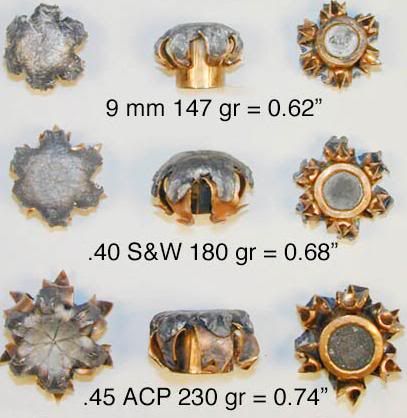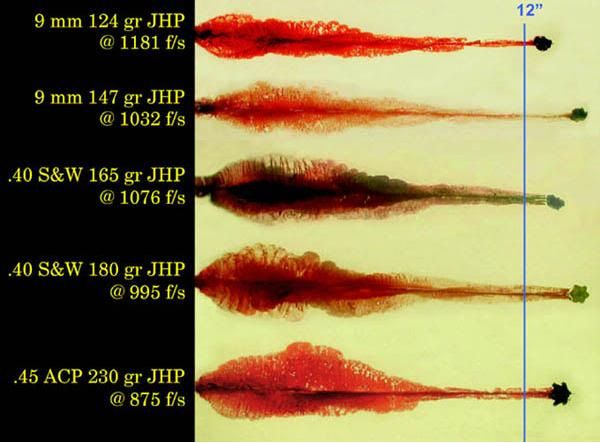
So why do I carry a 9mm, and why, as a firearms instructor, do I think you should too?
I don’t believe that it is likely to take only one shot to stop any threat. With this in mind, the data about the difference in potential performance from one bullet to the next or the relatively few examples of a single pistol round regardless of caliber, resulting in a threat being stopped, suggests to me that I should plan on multiple shots being fired. If I plan on needing more than one shot and I know that I want to stop the threat as soon as possible, then it makes sense that I should seek the fastest string of fire possible. Right? Physics shows that 9mm is going to be a more easily managed round (lower recoil) than the .40S&W or .45ACP out of any particular firearm. So, no matter how much you train or practice, everyone should be able to shoot a string of effective 9mm rounds faster than they can fire a string of .40S&W or .45ACP. If you stick with a probable target size(center chest) at a plausible distance (10-15’), it shouldn’t be hard to notice at a reasonable number of rounds (3-6).
If I’m ever involved in a self-defense situation, I have a feeling the threat is not going to be standing still like a target at my range. Most likely it's likely going to take at least a few hits to stop the threat. In other words, If the criminal is moving my hits might end up any number of places, other than center mass.
A 9mm allows for a quicker burst of shots due to lower recoil enabling me to get back on target quicker. If you believe that all you need is your .40 or .45 and one bullet to stop an attacker, what if that round hits the attacker's arm? By the time you’ve fired one round, I have fired 3-4 with my 9mm and the threat, hopefully should be stopped by then.
Aside from allowing me to shoot more quickly, the 9mm also lets me carry more rounds. Keep in mind that I am counting on needing more than one round. In any given size package, 9mm firearms hold more rounds than their counterparts chambered in .40S&W or .45ACP. Let's use my Glock for example, My G19(9mm) holds 17+1, the The Glock 23 is a .40S&W version of the compact Glock 19. It is dimensionally identical to the Glock 19 but is slightly heavier and has a standard magazine capacity of 13 rounds. There is no .45ACP equivalent. This gives me a greater potential for defense against one or more targets for the same practical cost in size & weight. I know that the majority of self-defense shootings are under 6 rounds, but I prefer having a 17 round magazine over an 8 round magazine. The way luck works my encounter will probably be the ~1% that requires more rounds. Don’t forget about the possibility of multiple attackers or the “flash mobs” that are so popular lately as either would probably require more ammunition.
Pistol rounds really aren’t great stoppers. I have several friends that are ER doctors and nurses who see gunshot wounds regularly. They have told me that most people survive gunshot wounds because a handgun round really isn’t that powerful. There is a reason that hospital emergency rooms successfully treat gun shot wound patients on a regular basis. There is a negligible difference between the wounding capacity of the 9mm and the .40 S&W. The idea of energy transfer is misplaced in regard to wounding potential because the amount of energy contained in a pistol bullet is pretty low when we think about really having dramatic effect on a human body. The damage is created through cutting and crushing. The difference of a few grains of weight, a few feet per second of speed or a millimeter of diameter, to me is not worth giving up on the faster strings of fire or the higher capacity mentioned above. Shot placement is key, due to this fact you'll need multiple accurate hits to stop a threat.

I am not arguing that a single .40S&W or .45ACP round doesn’t hold more potential to stop, but I believe that this small increase in potential is not worth the known shortcomings in recoil or magazine capacity. For all shooters, at some point, there will be a moment when they can fire one more round of 9mm in any given period of time. That extra round’s capacity to wound will far outweigh the miniscule difference in potential for any individual bullet.
It is significantly less expensive to shoot 9mm than it is to shoot .40 or .45 this means more training, in general, for any given budget. There is no doubt that it is a factor in favor of choosing the 9mm. As a firearms instructor I always recommend training with your actual carry gun as often and as realistically as possible.
The bottom line is, I’m very comfortable carrying my 9mm Glock and if the day ever comes where I have to defend a life I know the 9mm will serve me well. How comfortable and confident are you with your gun and choice of round?

